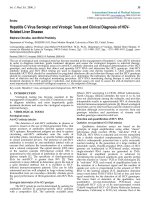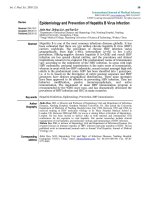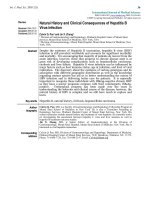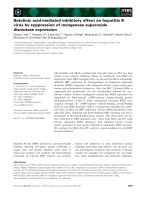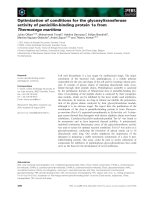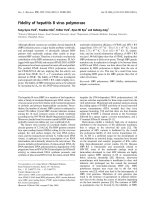COMPUTATIONAL CHARACTERIZATION FOR GENOME INTEGRATION SITES OF HEPATITIS b VIRUS (HBV) AND GENE TARGETS OF HBV x PROTEIN
Bạn đang xem bản rút gọn của tài liệu. Xem và tải ngay bản đầy đủ của tài liệu tại đây (2.22 MB, 158 trang )
COMPUTATIONAL CHARACTERIZATION FOR GENOME
INTEGRATION SITES OF HEPATITIS B VIRUS (HBV) AND GENE
TARGETS OF HBV X PROTEIN
LIU LIZHEN
NATIONAL UNIVERSITY OF SINGAPORE
2012
COMPUTATIONAL CHARACTERIZATION FOR GENOME
INTEGRATION SITES OF HEPATITIS B VIRUS (HBV) AND GENE
TARGETS OF HBV X PROTEIN
LIU LIZHEN
(B.Sc. (Hons.), NUS)
A THESIS SUBMITTED
FOR THE DEGREE OF MASTER OF SCIENCE
DEPARTMENT OF BIOCHEMISTRY
YONG LOO LIN SCHOOL OF MEDICINE
NATIONAL UNIVERSITY OF SINGAPORE
2012
ACKNOWLEDGEMENT
First, I wish to express my sincere gratitude to my supervisor, Associate Professor
Caroline Lee Guat Lay, Principal Investigator in National Cancer Centre of Singapore
and Associate Prof. under Department of Biochemistry, Yong Loo Lin School of
Medicine in National University of Singapore, for providing me such a good opportunity
to do this project and for her valuable guidance and enlightenment.
I would also like to extend my gratitude to my project collaborators Miss Toh Soo Ting,
Miss Chan Siew Choo Cheryl, and Dr. Wang Yu for providing me the high-throughput
Roche 454 pyrosequencing data, ChIP-Seq Illumina sequencing data, microarray
expression profiles, and HCC patient clinical data for analysis. I would like to thank them
for their unfailing guidance and help throughout the project. In addition, I would also like
to show my appreciation to all the other members of our research laboratory, especially
Mr. Mah Way Champ, Dr. Cao Yi, Miss Jin Yu and Mr. Wang Jingbo, for their
invaluable help, advice and suggestions during the course of this project. I would also
like to convey my heart-felt thanks to Associate Prof. Henry Yang He, Associate Prof.
Ken Wing Kin Sung, and Associate Prof. Tan Tin Wee for their support to complete this
thesis.
Last but not least, I wish to thank my beloved parents, my husband, and my good friends
for their understanding, love, support and encouragement.
i
TABLE OF CONTENTS
ACKNOWLEDGEMENT ................................................................................................... i
TABLE OF CONTENTS .................................................................................................... ii
SUMMARY ....................................................................................................................... vi
LIST OF FIGURES ........................................................................................................... ix
LIST OF TABLES ............................................................................................................. xi
ABBREVIATIONS .......................................................................................................... xii
CHAPTER 1: Literature Review and Introduction............................................................. 1
1.1 HBV-Host Genome Integration .................................................................................. 1
1.2 Limitation of PCR-based Methods to identify HBV-Host Genome Integrations ....... 2
1.3 Application of Targeted Deep Sequencing Techniques to Identify Viral-host
Integration Boundaries ................................................................................................ 3
1.4 Analysis of Targeted Deep Sequencing Data to Identify Viral-host Integration
Boundaries .................................................................................................................. 7
1.5 HBx-Interacting Transcription Factors ..................................................................... 11
1.6 Limitation of ChIP-Chip Methods to Profile Protein-DNA Interactions.................. 12
1.7 Application of ChIP-Seq Methods to Profile Protein-DNA Interactions ................. 16
1.8 Analysis of ChIP-Seq Data to Identify DNA-binding Sites of Proteins ................... 18
1.9 Motif Enrichment Analysis to Identify Co-Factors of Proteins ................................ 27
1.10 Project Objectives ..................................................................................................... 30
1.10.1 Computational Analysis for Characterization of HBV-Host Genome
Integration Sites ............................................................................................ 31
ii
1.10.2 Computational Analysis for Identification of Putative Deregulated Direct
Gene Targets of HBx .................................................................................... 35
1.10.3 Summary of Project Objectives .................................................................... 42
CHAPTER 2: Computational Characterization of HBV-Host Genome Integration Sites 45
2.1 Materials and Methods .............................................................................................. 45
2.1.1
Data Collection: HBV-containing DNA Fragments Enrichment and FLX
Sequencing Library Construction ................................................................. 45
2.1.2
Computational Identification of HBV-Host Junction Sites from FLX
Sequencing Data ........................................................................................... 46
2.2 Results ....................................................................................................................... 50
2.2.1
Sequence Identities of the FLX Sequencing Reads ...................................... 50
2.2.2
Sequence Capture Coverage of HBV Genome from FLX data .................... 53
2.2.3
Identification of Modified HBV and HBV-Human Genome Junctions ....... 54
2.2.4
Analysis of HBV-Host Junctions with Junction Points on HBx gene .......... 59
2.3 Discussion and Future Work..................................................................................... 63
CHAPTER 3: Computational Identification of Putative Direct Gene Targets of HBx .... 67
3.1 Materials and Methods .............................................................................................. 67
3.1.1
Data Collection: ChIP-Seq Libraries, Expression Profiles & 100 HCC
Patients Clinical Data.................................................................................... 70
3.1.2
Computational Identification of DNA Binding Sites of HBx ....................... 72
3.1.3
Annotation of Genome-wide Potential HBx Binding Sites .......................... 74
iii
3.1.4
Motif Enrichment Analysis for Potential HBx-interacting Transcription
Factors ........................................................................................................... 74
3.1.5
Analysis of THLE3 Microarray Expression Profiles to Predict Deregulated
Direct Gene Targets of HBx ......................................................................... 76
3.1.6
Gene Ontology Analysis for Deregulated Gene Targets of HBx ................. 76
3.1.7
Analysis of Microarray Expression Profiles of 100 HCC Patients ............... 77
3.1.8
HCC Patients Clinical Data Analysis to Identify Clinically Associated
Deregulated Gene Targets of HBx ................................................................ 77
3.1.9
Correlation of Expressions of HBx and HBx Deregulated Gene Targets in
100 HCC Patients Tumor and Adjacent Non-Tumor Tissues ...................... 81
3.2 Results ....................................................................................................................... 81
3.2.1
Analysis of ChIP-Seq Data and Identification of Potential DNA Binding
Sites of HBx .................................................................................................. 81
3.2.2
Genome-Wide Distribution of Potential DNA Binding Sites of HBx .......... 84
3.2.3
Potential HBx-Interacting Transcription Factors Predicted from HepG2
ChIP-chip and THLE3 ChIP-Seq Data ......................................................... 86
3.2.4
Potential HBx Deregulated Direct Gene Targets in THLE3 Cells ............... 90
3.2.5
Clinically Associated Potential HBx Deregulated Gene Targets ................. 91
3.2.5.1
Expression of Potential HBx Deregulated Gene Targets in HCC
Patients................................................................................................. 91
3.2.5.2
Association of Potential HBx Deregulated Gene Targets with HCC
Patient Survival Time .......................................................................... 92
3.2.5.3
Association of Potential HBx Deregulated Gene Targets with HCC
Patients’ Categorical Clinical Features ................................................ 97
iv
3.2.5.4
Summary of Associations of Potential HBx Deregulated Gene Targets
with HCC Patient Clinical Features ................................................... 101
3.2.6
Correlation of Clinically Associated HBx Deregulated Gene Targets with
HBx Protein Expression in the 100 HCC Patients ...................................... 105
3.3 Discussion and Future Work................................................................................... 106
CHAPTER 4: Conclusion and Future Work ................................................................... 113
4.1 Characterization of HBV-Host Genome Integration Sites in HCC Patients........... 114
4.2 Future Work on the Computational Analysis Pipeline in Identifying Virus-Host
Genome Integration Sites ........................................................................................ 115
4.3 Identification of HBx Genomic Binding Sites, HBx-interacting Transcription
Factors, and Clinically Associated Deregulated Direct Gene Targets of HBx ....... 117
4.4 Future Work on the Clinically Associated Gene Targets of HBx .......................... 122
4.5 Conclusion .............................................................................................................. 123
CHAPTER 5: Supplementary Tables ............................................................................. 124
References ....................................................................................................................... 130
Author’s Publications...................................................................................................... 144
v
SUMMARY
Chronic Hepatitis B viral (HBV) infection has been epidemiologically linked to the
development of Hepatocellular Carcinoma
(HCC) in patients. A significant
characterization of chronic HBV infection is the integration of HBV DNA into multiple
locations within the host DNA. This integration of viral DNA into host genome has been
implicated to contribute to hepatocarcinogenesis through either insertional-mutagenesis
or the retention/expression of the original/modified HBV proteins. One viral protein,
HBx, has been strongly suggested to play important roles in oncogenicity through the
deregulation of host genes. However, the association between chronic HBV infection and
HCC remains poorly understood.
Our laboratory had enriched for HBV sequences in 48 HBV-associated HCC patients and
employed the FLX Genome Sequencer to characterize variations in the HBV DNA as
well as HBV integration events in these patients. In this thesis, I employed a
computational workflow to analyze the high-throughput sequencing data, and identified
60 contigs/reads with altered HBV DNA and 63 contigs/reads carrying both HBV and
human DNA within the same read from which the HBV-HG junction sites were inferred.
Various variations such as insertions, deletions, duplications and inversions were
observed from the 60 altered HBV sequences. Interestingly, the HBV-HG integrations
were found to preferentially occur at the HBx gene locus (27/63=42.9%) and the 3’ Cterminal of HBx carrying p53 binding domain was often deleted to fuse with the human
genome. Deletion of p53 binding domain of HBx may potentially promote carcinogenesis
in HCC patients, as p53 is a well-known tumor suppressor. The N-terminal two third of
HBx gene carrying transactivation domains were often retained in the integrated form. In
vi
addition, most of the genome integrations were found to occur at the non-coding regions
of human genome, such as, gene promoters (4/63), introns (21/63) and intergenic regions
(30/63). Nevertheless, computational scanning of the integrated sequences for open
reading frames have shown that the genome integration may either lead to early
termination of HBV genes or expression of potential chimeric transcripts fusing HBV and
human DNA. Significantly, our laboratory has successfully experimentally validated a
subset of the integrated sequences and the expression of chimeric transcripts. By
characterization of HBV genome integration sites using high throughput targeted genome
sequencing, we are now better positioned to gain improved insights on how HBV genome
integration may contribute to hepatocarcinogenesis in HCC patients.
To further elucidate the role of the HBx gene in HCC, our laboratory employed
chromatin immunoprecipitation and sequencing using the Solexa Genome Sequencer
(ChIP-Seq) on immortalized liver cell line, THLE3 using HBx antibodies. I employed a
computational workflow to integrate the high throughput ChIP-Seq data, microarray
expression profiles for both cell lines (THLE3) and 100 HBV-associated HCC patients,
and the clinical data of the 100 HCC patients. A total of 2860 potential HBx binding sites
were identified and were found to be significantly enriched in exons and promoter
regions of genes (p<0.00001). Interestingly, almost half of the predicted binding sites
within exons/introns were localized in the first and last exons/introns, indicating the
potential regulatory effect of HBx on gene expressions. 195 potential HBx-interacting
transcription factors were predicted, of which 129 were commonly predicted from our
previous ChIP-chip data on HepG2 cells. 143 potential HBx deregulated direct gene
targets were identified in THLE3 cells, indicating the pleiotropic nature of HBx: interact
vii
with a variety of transcription factors and deregulate a large set of genes. 18 of these 143
HBx-associated deregulated genes were also consistently differentially deregulated in the
100 HCC patients. Seven of these 18 genes were found significantly associated with
various patients’ clinical features including survival, tumor grade, tumor invasion, liver
cirrhosis, tumor capsulation and multifocality. By identification of clinically associated
potential HBx deregulated direct gene targets, we are now in a better position to explore
the role of HBx in hepatocarcinogenesis in HCC patients.
viii
LIST OF FIGURES
Figure 1.1: Hybrid capture to capture viral-host integration sites ...................................... 7
Figure 1.2: ChIP-chip and ChIP-Seq workflow. ............................................................... 14
Figure 1.3: Analysis of ChIP-Seq sequencing data .......................................................... 19
Figure 1.4: Bimodal enrichment pattern of ChIP-Seq sequencing data............................ 25
Figure 1.5: Aims of the project. ........................................................................................ 44
Figure 2.1: Flowchart of the HBV enrichment strategy applied in our laboratory. .......... 46
Figure 2.2: Analysis pipeline for identification of HBV-human junctions from 454 FLX
sequencing data ................................................................................................................. 47
Figure 2.3: Typical patterns of HBV-containing sequence identities ............................... 50
Figure 2.4: Summary of sequence identities for all 1,902,755 raw FLX sequencing reads
........................................................................................................................................... 51
Figure 2.5: Coverage of the HBV genome (3215bp) by the 378 HBV-containing
sequences including 220 assembled contigs and 158 unassembled reads in patients....... 54
Figure 2.6: Enrichment of HBV-HG junctions with integration sites on HBx gene ........ 57
Figure 2.7: Location plot of the 27 predicted HBV-HG junctions where the junction
points fall on HBx gene (Supplementary Table S2) ......................................................... 62
Figure 3.1: Workflow of computational analysis to identify genomic binding sites of HBx
and putative clinically associated direct target genes of HBx .......................................... 68
Figure 3.2: Flowchart of experimental design for generation of ChIP-Seq data and gene
expression profiles performed in the laboratory ............................................................... 71
ix
Figure 3.3: Flowchart of the statistical hypothesis testing on the association of HBx
deregulated gene targets with patient clinical data ........................................................... 79
Figure 3.4: Processing of ChIP-Seq raw reads to identify potential HBx binding sites. .. 82
Figure 3.5: Genome-wide distribution of the 2860 potential DNA binding sites of HBx
predicted from ChIP-Seq data in THLE3 cells ................................................................. 85
Figure 3.6: Summary of the computational analysis results for identification of HBx
binding sites, potential HBx-interacting transcription factors and HBx deregulated direct
gene targets ....................................................................................................................... 89
Figure 3.7: Hierarchical clustering of the 23 potential HBx deregulated gene targets that
are significantly differentially expressed between tumor and adjacent non-tumor tissues
of the 100 HCC patients with average fold change above 2 ............................................. 92
Figure 3.8: Survival plots for the four survival-associated potential HBx deregulated gene
targets ................................................................................................................................ 96
Figure 3.9: Plots for the six potential HBx deregulated gene targets that showed
significant associations with the 100 HCC patients’ categorical clinical features ........... 99
Figure 3.10: Scatter plots for the expressions of the seven potential HBx deregulated gene
targets and expressions of HBx protein in 100 HCC patients ........................................ 106
x
LIST OF TABLES
Table 1.1: Comparison of metrics and performances of three next-generation DNA
sequencing platforms and two third generation sequencing technologies .......................... 5
Table 1.2: Comparison of metrics and performances of ChIP-chip and ChIP-Seq
technologies ...................................................................................................................... 17
Table 1.3: Comparisons of various peak-calling algorithms for ChIP-Seq data .............. 23
Table 2.1: Summary of the identities of the 378 HBV-containing sequences. ................. 56
Table 2.2: Summary of the locations of the 63 junction points on human genome. ........ 59
Table 3.1: Comparisons of ChIP-chip data on HepG2 cells (Sung et al., 2009) and ChIPSeq data on THLE3 cells. ................................................................................................. 87
Table 3.2: Summary of corrected two-sided significance values from the clinical
statistical tests on the 18 potential HBx deregulated gene targets. ................................... 94
Table 3.3: Summary of the clinical associations for the seven potential HBx deregulated
gene targets ..................................................................................................................... 103
Table 3.4: Functional annotations of the seven clinically associated potential HBx
deregulated gene targets .................................................................................................. 104
Supplementary Table S1: Number of sequences (assembled contigs and unassembled
reads) that were classified into the five major groups in each patient sample ................ 124
Supplementary Table S2: Information for 56 HBV-HG junctions and seven modified
HBV-HG junctions predicted in different patient samples. ............................................ 125
Supplementary Table S3: List of the 195 enriched transcription factors from ChIP-Seq
data in THLE3 cells, among which 129 were common with the transcription factors
predicted from ChIP-chip data in HepG2 cells ............................................................... 127
xi
ABBREVIATIONS
BLAST
Basic Local Alignment Search Tool
CCAT
Control-based ChIP-Seq Analysis Tool
ChIP-
Chromatin Immunoprecipitation
DAVID
Database for Annotation, Visualization and Integrated Discovery
FDR
False Discovery Rate
HBV
Hepatitis B Virus
HBx
Hepatitis B virus X gene
HCC
Hepatocellular Carcinoma
HOMER
Hypergeometric Optimization of Motif Enrichment
MACS
Model-based Analysis for ChIP-Seq
NGS
Next Generation Sequencing
IP
Immunoprecipitation
UTR
Un-Translated Region
SPSS
Statistical Package for the Social Sciences
TSS
Transcription Start Site
xii
CHAPTER 1: Literature Review and Introduction
1.1
HBV-Host Genome Integration
Hepatocellular carcinoma (HCC) is the fifth most common subtype of liver cancer
and is found to be the third leading cause of cancer death in the world due to late
diagnosis and limited treatment options (Blum, 2005; Lupberger and Hildt, 2007).
There are many risk factors that may cause the development of HCC, including
chronic infections of hepatitis B or C virus (HBV/HCV), aflatoxin exposure and
excessive alcohol consumption. However, the most epidemiologically associated
risk factor is HBV infection, as it has been estimated that chronic HBV infection
accounts for 50-55% of all HCC cases in the world (Arbuthnot and Kew, 2001;
Chang, 2003; Lupberger and Hildt, 2007; Parkin et al., 2001). As HBV infection
precedes the development of HCC by several years, the time gap could allow
multiple cellular events such as genetic or chromosomal changes to occur which
eventually lead to HCC. One of the key mechanisms in hepatocarcinogenesis
involves the integration of HBV genome into the host genome, which is observed
in 85-90% of HCC cases and has been reported by many isolated studies to play
important roles in HCC development (Bonilla Guerrero and Roberts, 2005;
Buendia, 1992; Robinson, 1994). HBV genome integration occurs at early stage
after HBV infection and is reported to contribute to host chromosomal instability
by various complex genome alteration events which may result in large inverted
duplications, deletions, and chromosomal translocations (Tan, 2011). Studies also
have shown that frequent HBV genome integrations and variations may disrupt
1
host genes that are essential for cell signalling, proliferation and apoptosis
(Boyault et al., 2007; Kuang et al., 2004; Murakami et al., 2005; Paterlini-Brechot
et al., 2003; Saigo et al., 2008; Tan, 2011). Therefore, HBV-host genome
integrations and alterations may play a crucial role in HBV-induced development
of HCC. However, the detailed mechanism of how HBV genome integration may
gradually lead to hepatocarcinogenesis in HCC patients remains unclear (Ng and
Lee, 2011; Tan, 2011).
1.2
Limitation of PCR-based Methods to identify HBV-Host
Genome Integrations
Previously, many research groups have characterized HBV integrations using
PCR-based (Polymerase Chain Reaction) methods such as HBV-Alu-PCR which
designed one primer specific to HBV sequence and another primer directed to the
most abundant mobile Alu elements/repeats of human genome to amplify the
virus/cellular DNA junctions (Tu et al., 2006), cassette-ligation mediated PCR
which used cassette-ligated human genome DNA fragments adjacent to the
integrated HBV DNA as a template for nested PCR with the cassette- and HBVspecific primers to identify HBV integration sites from the HBV DNA amplified
from HCC patient liver tissues (Saigo et al., 2008; Tamori et al., 2003; Tamori et
al., 2005), and low resolution southern blot which hybridized the HBV DNA
extracted from HCC patient tumor tissues with the HBV DNA regions as probes
to identify integrated HBV DNA sequences (Tamori et al., 2003; Urashima et al.,
1997) etc. These methods combining PCR and capillary sequencing have shown
2
that HBV integration sites might not be entirely random as generally believed,
and more importantly, HBV was observed to be mutated or truncated in the
integrated form.
As a result, due to the lack of knowledge on the virus sequences retained in the
integrated form and the extremely high sensitivity of PCR, a potential problem
associated with PCR methods is that primers designed may reside at truncated or
mutated or polymorphic regions of the virus genome, resulting in failure in
amplification and thus leading to potential increased false negative rates in
discovering virus-host integration sites. In addition, without prior knowledge of
the virus integrated sequences, PCR primers and reactions covering the whole
virus genome may be required in order to fully characterize the virus integration
sites, and this would be extremely labour intensive to carry out. More efficient
and higher resolution techniques are needed for detection of virus integration sites
in a genome-wide scale in order to overcome the limited prior knowledge of
integration sites. In recent years, targeted genome sequencing-based approaches
have rapidly replaced PCR-based methods (combination of PCR and capillary
sequencing) to discover genome structural variants including virus-host
integrations (Ansorge, 2009; Mardis, 2009).
1.3
Application of Targeted Deep Sequencing Techniques to
Identify Viral-host Integration Boundaries
The low throughput and high cost of the traditional Sanger capillary-based
sequencing has been a key limiting factor for full-sequencing-based approaches.
3
There has been increased demand for the development of low-cost and highthroughput sequencing technologies. In recent years with the emergence of "Next
Generation Sequencing" (NGS) technologies such as Roche/454 Life Sciences™,
Illumina/Solexa™ Sequencing and Applied Biosystems SOLiD™, sequencing
costs have been brought down by several orders of magnitude and throughput has
been raised by hundreds of folds (Shendure and Ji, 2008). In addition, third
generation sequencing techniques, such as Ion Torrent™ semiconductor
sequencing, Complete Genomics™ DNA Nanoball (DNB) sequencing (Drmanac
et al., 2010; Porreca, 2010), etc. are providing another big boost to this approach
with ever higher throughput and lower cost. These deep sequencing techniques
enable parallelization of sequencing processes, producing millions of sequence
reads at once. Table 1.1 compares the performances of three next-generation
sequencing platforms and two third generation sequencing technologies.
In particular, Roche 454 Life Sciences has the ability to sequence whole genomes
in days, with 99% accuracy and at a cost of 100x less than using the capillarybased sequencing methods. Besides, the Roche FLX 454 pyrosequencing
technology can even achieve average read length of 400bp which has drastically
increased the sequencing depth and capacity. Development of these high-accuracy,
high-throughput and low cost sequencing techniques has improved the
applications of sequence-based methods to a whole genome scale with fine-tuned
resolution to single base precision (Mardis, 2008a, b; Schuster, 2008; Stephens et
al., 2009).
4
Table 1.1: Comparison of metrics and performances of three next-generation
DNA sequencing platforms and two third generation sequencing technologies:
454 pyrosequencing, Illumina Solexa sequencing, Applied Biosystems SOLiD
sequencing, Ion Torrent semiconductor sequencing and Complete Genomics
DNA Nanoball sequencing (DNB). (Table updated from Shendure and Ji 2008)
Next Generation Sequencing
Deepsequencing
platforms
454
pyrosequencing
Third Generation Sequencing
Applied
Biosystems
SOLiD
sequencing
Illumina (Solexa)
sequencing
Ion Torrent
Semiconductor
sequencing
Complete Genomics
DNA Nanoball
sequencing
umina. lie
pletegen
http://www.454.c
t
com/pages.ilmn?ID= dbiosystems.com.
omics.com/services/tech
om
orrent.com/
204
sg/
nology/details/
URL
Sequencing
Chemistry
Pyrosequencing
Polymerase-based
sequence-bysynthesis
Ligation-based
sequencing
Semiconductor
sequencing
Unchained ligationbased sequencing
Amplification
approach
Emulsion PCR
Bridge amplification
Emulsion PCR
Emulsion PCR
rolling circle replication
Mb per run
100 Mb
600,000 Mb
170,000 Mb
100 Mb
180,000 Mb
Time per run
7 hours
9 days
9 days
1.5 hours
12 days
Read length
400 bp
2x100 bp
35x75 bp
200 bp
35 bp (mate-pair)
Cost per run
$8,438 USD
$20,000 USD
$4,000 USD
$350 USD
Cost per Mb
$84.39 USD
$0.03 USD
$0.04 USD
$5.00 USD
$20,000 USD per
genome
Cost per
instrument
$500,000 USD
$600,000 USD
$595,000 USD
$50,000 USD
N.A
Nowadays, a variety of techniques that specifically capture genomic genes or
regions of interest from genomic samples coupled with ultra-high throughput
NGS sequencers, has been increasingly adapted for and applied in cancer research
for
the
detection
of
larger
genome
structural
variants,
including
insertions/deletions, translocations and viral insertions (Abel et al., 2010;
Duncavage et al., 2011; Hernandez et al., 2011; Mardis, 2009; Stephens et al.,
2009). Such targeted deep sequencing narrows down the sequencing to important
genes or regions of interest instead of the entire genome. It allows analysis of
interesting genomic sequence variants more efficiently and at even lower cost,
5
especially in the context that NGS has the capacity to sequence multiple
experimental samples in a single run by using “barcodes” or indexed labels for
individual samples (Mardis, 2008; Abel et al., 2010). To reduce costs, it is often
necessary to select regions of interest before sequencing. There are several target
enrichment methods, including standard PCR, ligation-based PCR or hybrid
capture (Mamanova et al., 2010; Summerer, 2009). In the context of viral-human
genome integration, hybrid capture enrichment adopts a basic principle that uses
viral-specific probes to hybridize with DNA fragments containing viral sequences
or viral-human integration boundaries. The un-hybridized DNA fragments
containing only human sequences are washed away, and the captured DNA
sequences of interest are then eluted for deep sequencing (See Fig 1.1). Analysis
of the deep sequencing data can identify chimeric sequences which contains the
viral-host integration boundaries. Hybrid capture is advantageous over PCR-based
enrichment approaches by allowing identification of novel viral integration sites
or translocation breakpoints (Abel et al., 2010; Mamanova et al., 2010).
With limited knowledge of HBV-human integration sites and to fully characterise
HBV-human integrations over whole genome, our laboratory has proposed to
apply the hybrid capture enrichment strategy to capture DNA fragments
containing HBV sequences or HBV-host integration sequences from the complex
HCC patient genomic DNA samples, coupled with ultra-high throughput FLX
454-pyrosequencer, to identify the chimeric sequences representing HBV-human
integration sites. As part of a larger research project in our HBV research
6
laboratory, I have proposed an analysis pipeline for the ultra-high throughput FLX
sequencing data to characterize HBV-human genome integration sites.
Figure 1.1: Hybrid capture to capture viral-host integration sites. Human genomic
DNA (green) containing inserted viral genome (red) is first fragmented to certain
size. The fragmented DNAs are then hybridized with capture probes that are
specific and complementary to viral DNA sequences, and subsequently fragments
not containing virus DNA are washed away. The captured DNA containing viral
sequences are then eluted for deep sequencing. By analyzing the sequencing data,
chimeric reads consisting of the human/virus integration boundaries can be
identified.
1.4
Analysis of Targeted Deep Sequencing Data to Identify Viral-
host Integration Boundaries
Targeted genomic regions of interest can be sequenced at great depth using next
generation sequencing technologies. There have been several programs developed
to date that analyse deep sequencing data for locating sequence variants, such as,
Pindel (Ye et al., 2009), BreakDancer (Chen et al., 2009), MoDIL (Lee et al.,
2009), PEMer (Korbel et al., 2009), VariationHunter (Hormozdiari et al., 2010),
7
and SLOPE (Abel et al., 2010) etc. Pindel, BreakDancer, MoDIL, PEMer and
VariationHunter are specifically designed to analyse sequence data generated
from whole genomes while SLOPE is developed to analyse targeted sequence
data. Pindel identifies insertions/deletions with single-base resolution but is not
designed to detect virus insertion boundaries or sequence breakpoints.
BreakDancer, MoDIL, PEMer, VariantionHunter and SLOPE rely on discordant
mapping of paired-end diTag sequencing data to detect genome structural variants.
Paired-end diTag sequencing of targeted DNA fragments is one of the popular
strategies used to discover genome-wide sequence structural variations, based on
the principle that the paired-end tags generated from high-throughput sequencer
can be aligned back to the host reference genome sequences and abnormal
separations or locations between the two reads of a pair suggest a potential
genome structural variation, like insertion, deletion, rearrangements and
translocation (Bashir et al., 2008; Korbel et al., 2007; Ng et al., 2006; Ruan et al.,
2007; Tuzun et al., 2005; Volik et al., 2003). However, the problem associated
with these discordant paired-end strategies in characterizing virus-host integration
boundaries is that they generally cannot achieve single-base resolution and might
have relatively high false positive rates because of limited prior knowledge of the
virus insertion size (Mardis et al., 2009). Hence, due to limited prior knowledge
of the HBV virus insertion size in human genome and in order to
comprehensively characterize the integration sites precisely in single-base
resolution, we embarked single-end sequencing with FLX 454 pyrosequencer
which is capable of generating significantly longer reads.
8
Analysis of the single-end high-throughput sequencing data usually begins with
the alignment of the sequencing reads back to the entire host reference genome,
and this mostly is the key limiting and time-consuming step in the analysis
process. Currently, there are many available sequence assembly software
designed for aligning deep sequencing data, including:
a) de novo assemblers that merge sequences based on overlaps between sequence
reads, such as, ABySS (Simpson et al., 2009), SSAKE (Warren et al., 2007),
VCAKE ( EULER-SR (Chaisson and Pevzner,
2008),
Velvet
(Zerbino
and
Birney,
2008),
MIRA
(http://mira-
assembler.sourceforge.net/docs/DefinitiveGuideToMIRA.html),
and
NextGENe ( />b) reference-guided assemblers that map sequence reads to a known reference
genome, such as, RMAP (Smith et al., 2009; Smith et al., 2008), SeqMap
(Jiang and Wong, 2008), SHRiMP ( />ZOOM (Lin et al., 2008), MAQ ( NovoAlign
( />
GenomeMapper
( />
MOSAIK
( BWA (Li and Durbin,
2009, 2010) and Bowtie (Langmead et al., 2009);
c) assemblers that can do both de novo and reference-guided assembly, including
SOAP
(Li
et
al.,
2008),
CLC
Genomics
Workbench
9
(www.clcbio.com/genomics/),
and
DNASTAR
SeqMan
NGen
( />A common feature of these sequence assemblers is that they are computationally
intensive requiring large computational power and processing memory. Besides
being time-consuming, most of these assemblers are either only suitable for small
genomes, or are restrained to a limited number of input sequences in each
assembly run, or restricted to certain sequence read length. FLX 454
pyrosequencer generates sequence reads of variable lengths ranging from thirty to
thousands base pairs. A commercial assembler, the SeqMan NGen which is
developed by the company DNASTAR, is fast, accurate and specifically designed
for 454 pyrosequencing reads with no restrictions on the number of input
sequences and sequence lengths. SeqMan NGen was found to be ideal for de novo
assembly of 454 pyrosequencing data, permitting closely examination of the
quality and reliability of the assembled sequences for post-assembly analysis.
Although SeqMan NGen was designed for 454 sequencing data, it is less suitable
for identifying virus-host integration boundaries compared to the standalone
BLAST (Basic Local Alignment Search Tool) program (Altschul et al., 1997).
This is because SeqMan NGen can only detect the alignments where the full
length of the sequencing reads match to the reference genome when doing
reference-guided assembly, while BLAST searches for local alignments between
the reads and reference genomes allowing identification of reads with one part
mapped to virus genome and the other part aligned to host genome, thereby
10
leading to the identification of virus-host integration sites. BLAST is the most
commonly used tool to search against large genome sequence databases, and is
perfectly suitable for sequencing reads of variable lengths. Also BLAST provides
additional options for users to set the mapping thresholds to adjust the stringency
of alignments, such as matching identities, E-values and low complexity filter etc.
In this study, I implemented an analysis workflow utilizing BLAST to map the
targeted high-throughput single-end deep sequencing reads of variable lengths to
both human and virus reference genome sequences, in order to identify the virushuman integration boundaries.
1.5
HBx-Interacting Transcription Factors
Due to unresponsiveness to treatment and late symptom recognition, HCC is one
of the most common and lethal cancer in the world (Blum, 2005; Lupberger and
Hildt, 2007). It is estimated that 50-55% of HCC cases in the world are associated
with chronic infection of HBV (Parkin et al., 2001). The viral X-gene (HBx) of
HBV is conserved among all mammalian hepadnaviruses and the HBx protein has
been implicated to play a major role in the development of HCC in chronic HBVinfected patients.
HBx is a multifunctional protein of length 154-amino acids. It acts as a
promiscuous transactivator that disrupts host cellular gene expressions and
subsequent cellular pathways, such as, signalling pathways, DNA repair
mechanisms, proliferation, and apoptotic cell death (Becker et al., 1998;
Groisman et al., 1999; Lee and Lee, 2007; Matsuda and Ichida, 2009), which
11

